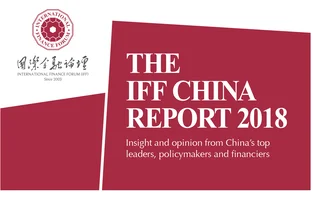
Establishing a multilayered banking system to support the real economy
Wang Yuan, IFF Academic Committee member and former chief economist at the China Development Bank, discusses why China must let the market play the decisive role in allocating market resources


China surpassed the US as the world’s largest manufacturing country in 2010. This could never have been accomplished without financial support such as bank and capital market financing, as private capital and government funds alone are far from sufficient. The course of economic reform and the transition from a centrally planned economy to a market system requires banking institutions and capital markets to play a more important role in promoting the development of infrastructure and manufacturing industries in China.
Bank financing and credit enhancement
Some argue that financial institutions did not provide sufficient finance in the real economy, as adequate support is not in place. The reality is China has relied on indirect financing for a long time, which means bank loans are the major source of finance for these enterprises. Prior to the 1980s, investment capital came largely from public finance, while banks provided only working capital. For example, working capital required by manufacturing industries was mostly short-term – no longer than one year – and the long-term investment required by state-owned enterprises (SOEs), which generally came from the public budget, was unsustainable. The expansion of the production scale was constrained by the limited source of finance. Since the 1980s, the average growth rate of the Chinese economy has been around 10% annually. It is crucial to break up the bottleneck of financing. Therefore, the reform of the financial sector, including banks and capital markets, has been a high priority on the reform agenda.
Banks provide credit enhancement as well as capital to companies to be listed on capital markets. If companies want to issue bonds, ratings companies would review the credit history of the companies with the bank. But, if companies fail to borrow money from banks, their corporate ratings be downgraded, which makes issuing bonds even harder as costs will be higher.

Making contact with high-quality customers
In the 1980s, major banks in China were specialised in their respective business areas. There was no overlap of their business, thus, no competition among the state banks. For example, the Industrial and Commercial Bank of China provided mostly household deposit services and offered loans to customers in industrial and commercial fields, the China Construction Bank focused on capital investment finance, the Bank of China provided rate finance and the Agricultural Bank of China based its activities in the vast rural hinterlands. Only the Bank of China could carry out foreign exchange business. However, in the past 20 years, banks in China have undergone massive changes and developed a completely new system.
The ownership of the banks has been diversified, in addition to those banks with the state as their major shareholder. There are shareholding banks, private banks, joint-venture banks and fully foreign-owned banks operating in the market. For the business scope, all fully licensed banks are allowed to operate in renminbi and foreign exchange.
Now banks in China are operating in a quite competitive environment, not only for attracting deposits but also for retaining high-quality customers for loans.
In the meantime, the financial regulatory system was established to put the risk control in the banks’ management.
Establishing a multilayered banking system
The Chinese banking system needs to be further diversified – if the service would cover all types of clients and vast geographic regions, in the area of financing, small and medium-sized enterprises (SMEs), small-scale regional banks and micro-financing companies play very important roles. The slogan for many microloan banks is ‘know your customer’, so that banks and customers share common ground, which in turn helps banks find high-quality customers. Additionally, customers who borrow from the bank can expand their businesses, which is creating a virtuous circle for both customers and banks.
The China Development Bank (CDB) is a state-owned wholesale bank. Its traditional business is financing infrastructures and urban utilities as well as high-tech industry. The bank’s chairman, Chen Yuan, believes everyone should enjoy equal financing rights – an innovation in financial services. Also, the bank should perform its social responsibility in supporting economic and social development. In the past 10 years, CDB’s operations have also extended to micro-finance and SMEs. The fund wholesaled the loans to urban and rural commercial banks and lend to SMEs.
The financial services industry develops a synergy with industries, as banks cannot survive on their own. Many criticise banks for not lending enough to real sectors, but limiting the funds circulating within the financial system, but the current regulatory system in China does not allow bank funds to enter the capital market, may cause turbulence within the financial system.
Supporting the real economy via banking institutions
If comprehensive reform does not occur in the area of SOE reform, the banking system will find itself trapped in a vicious circle. Banks are obliged to support SOEs. With the protection of the government, the financing from the banks will not be sustainable. Meanwhile, creating a social security system, will relieve banks of the burden of injecting loans to loss-making enterprises that otherwise would have gone bankrupt.
Many banks are now listed companies in both Shanghai and Hong Kong. Profit-making is also an important objective of these banks. They would not be able to support SOEs at their own loss.
The report of the 19th National Congress of the Communist Party of China (CPC) proposed that, in the next five to 10 years, China should continue carrying out reform and the financial industry must stay on the right track. For historical reasons, state-owned financial institutions account for a large proportion of China’s financial system but, in the future, private capital must be allowed to enter the financial realm.
Recently, the China Securities Regulatory Commission announced that foreign capital is now permitted to own up to 51% of total shares of a security firm, a very big step forward to ‘opening‑up’ the capital market in China. The shareholding structures of asset management companies and futures companies have also been relaxed.
The world is watching China with high expectations – but with concerns. President Xi Jinping identified potential future directions at the 19th CPC National Congress; however, the media merely reiterated President Xi’s remarks, rather than initiating practical and realistic discussion. It is more important to openly debate how to formulate and implement policies, and identify the problems still to be solved.
Finally, an economy with mixed ownership should be encouraged. Different types of ownership were emphasised at the 19th CPC National Congress; this lays out the trajectory to give foreign and domestic private capital access to financial services. Supporting the real economy is not just a slogan – there is a need to implement the right policies for economic and social development, to have a financial regulatory system that is conducive to providing sustainable support to the real economy. To summarise, China must carry out further reform: by opening‑up its economy on a larger scale, reducing administrative intervention and letting the market play the decisive role in allocating resources.
Only users who have a paid subscription or are part of a corporate subscription are able to print or copy content.
To access these options, along with all other subscription benefits, please contact info@centralbanking.com or view our subscription options here: subscriptions.centralbanking.com/subscribe
You are currently unable to print this content. Please contact info@centralbanking.com to find out more.
You are currently unable to copy this content. Please contact info@centralbanking.com to find out more.
Copyright Infopro Digital Limited. All rights reserved.
As outlined in our terms and conditions, https://www.infopro-digital.com/terms-and-conditions/subscriptions/ (point 2.4), printing is limited to a single copy.
If you would like to purchase additional rights please email info@centralbanking.com test test test
Copyright Infopro Digital Limited. All rights reserved.
You may share this content using our article tools. As outlined in our terms and conditions, https://www.infopro-digital.com/terms-and-conditions/subscriptions/ (clause 2.4), an Authorised User may only make one copy of the materials for their own personal use. You must also comply with the restrictions in clause 2.5.
If you would like to purchase additional rights please email info@centralbanking.com test test test







